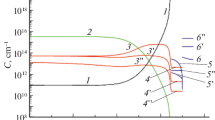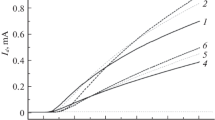Abstract
Based on the concepts of the significant role of the surface neutralization of positive ions at the boundaries of the oxide layer in the processes of ion transport in an insulating gap of MOS structures, the origin of a well-pronounced asymmetry in the temperature and temporal characteristics of the volume-charge ionic polarization/depolarization of an insulator are analyzed. The neutralization of ions occurs owing to the tunneling capture of electrons from semiconducting and metallic contacts. Experimental data obtained in a wide range of variations in the gate potential V g and related to the thermally stimulated and isothermal polarization of oxide in Si-MOS structures consistently support the asymmetry model that accounts for a higher degree of neutralization of ions and a higher coupling of ions to electrons at the metal surface (gate) than at the semiconductor surface. The transients exhibit three stages during polarization. The first of these is related to the transport of unneutralized (free) ions; in the initial stages of thermally stimulated and isothermal polarization for V g=const, the ions move in the oxide ballistically. In the second stage, a transition from the mode of free-ion drift to the modes of hyperbolic and (or) exponential kinetics of relaxation is observed; in the latter case, the current becomes virtually independent of the field, temperature, and the rates of the field or temperature scans and becomes a single-valued function of actual time. In this case, the law of relaxation is defined by the rate of tunneling ionization of neutral associations of ion + electron and (or) by their diffusion and thermal decomposition in the bulk of the insulator.
Similar content being viewed by others
References
M. Yamin, IEEE Trans. Electron Devices 12, 88 (1965).
M. Kuhn and D. J. Silversmith, J. Electrochem. Soc. 118, 966 (1971).
A. G. Tangena, N. F. de Rooij, and J. Middelhock, J. Appl. Phys. 49, 5576 (1978).
T. Hino and K. Yamashita, J. Appl. Phys. 50, 4879 (1979).
E. I. Gol’dman, A. G. Zhdan, and G. V. Chucheva, Fiz. Tekh. Poluprovodn. (St. Petersburg) 31, 1468 (1997) [Semiconductors 31, 1268 (1997)].
E. I. Gol’dman, A. G. Zhdan, and G. V. Chucheva, Fiz. Tekh. Poluprovodn. (St. Petersburg) 33, 962 (1999) [Semiconductors 33, 877 (1999)].
G. S. Horner, M. Kleefstra, T. G. Miller, and M. A. Peters, Solid State Technol., No. 6, 79 (1995).
G. Ya. Krasnikov, Élektron. Tekh., Ser. 3, No. 1, 67 (1996).
T. Shimatani, S. Pidin, and M. Koyanagi, Jpn. J. Appl. Phys., Part 1 36(3B), 1659 (1997).
G. V. Chucheva, Candidate’s Dissertation (Moscow, 1998).
E. H. Nicollian and J. R. Brews, MOS (Metal Oxide Semiconductor) Physics and Technology (New York, Wiley, 1982).
E. I. Gol’dman, A. G. Zhdan, and G. V. Chucheva, Fiz. Tekh. Poluprovodn. (St. Petersburg) 33, 933 (1999) [Semiconductors 33, 852 (1999)].
E.I. Gol’dman, A. G. Zhdan, and G. V. Chucheva, Prib. Tekh. Éksp., No. 6, 110 (1997).
K. H. Nickolas and J. Woods, Br. J. Appl. Phys. 15, 783 (1964).
L. I. Grossweiner, J. Appl. Phys. 24, 1306 (1953).
A. G. Zhdan and N. A. Lushnikov, Fiz. Tekh. Poluprovodn. (Leningrad) 16, 793 (1982) [Sov. Phys. Semicond. 16, 509 (1982)].
M. A. Lampert and P. Mark, Current Injection in Solids (Academic, New York, 1970; Mir, Moscow, 1973).
S. Sze, Physics of Semiconductor Devices (Wiley, New York, 1981; Mir, Moscow, 1984).
T. W. Hickmott, J. Appl. Phys. 46, 2583 (1975).
M. R. Boudry and J. P. Stagg, J. Appl. Phys. 50, 942 (1979).
S. R. Hofstein, IEEE Trans. Electron. Devices ED-13, 222 (1966).
G. Greeuw and J. F. Verwey, J. Appl. Phys. 56, 2218 (1984).
E. I. Gol’dman, Fiz. Tekh. Poluprovodn. (St. Petersburg) 34 (2000) (in press) [Phys. Solid State 34 (2000) (in press)].
K. Vanhensden, W. L. Warren, R. A. B. Devine, et al., Nature (London) 368, 587 (1997).
Author information
Authors and Affiliations
Additional information
__________
Translated from Fizika i Tekhnika Poluprovodnikov, Vol. 34, No. 6, 2000, pp. 677–681.
Original Russian Text Copyright © 2000 by Gol’dman, Zhdan, Chucheva.
Rights and permissions
About this article
Cite this article
Gol’dman, E.I., Zhdan, A.G. & Chucheva, G.V. On the origin of the thermal-field asymmetry in ionic polarization/depolarization of oxide in Si-MOS structures. Semiconductors 34, 650–654 (2000). https://doi.org/10.1134/1.1188047
Received:
Accepted:
Issue Date:
DOI: https://doi.org/10.1134/1.1188047




